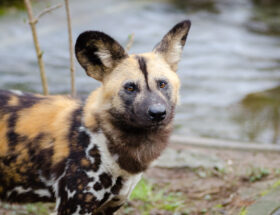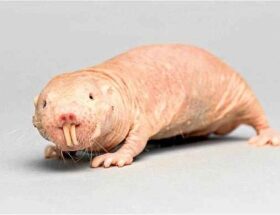Arctic Fox Facts! Learn about wildlife with us! In this post, you will find information about the Arctic Fox, and their incredible adaptations, habitat, diet, and conservation status and efforts!


Quick and Easy Navigation
The Arctic Fox Incredible Adaptations
The Arctic fox (Vulpes lagopus), is a small mammal native to the arctic circle region. This includes parts of Alaska, Canada, Greenland, Russia, Norway, Scandinavia, Finland, Sweden, and Iceland. They are mostly found in the treeless Arctic tundra. Other names include white fox, polar fox, or snow fox.
The arctic fox has incredible adaptations to survive in the harsh environment of the treeless Arctic tundra. The temperatures in this biome can reach temperatures as low as -58 degrees Fahrenheit. In addition to their beautiful white, furry, and thick coat, they have furry soles, short ears, and a short muzzle. All these features are important to survive in the frigid cold. They use their bushy tails as a blanket. They wrap their tail around their bodies while they sleep to retain their body heat. Just like Red Pandas! During a blizzard, they are able to tunnel into the snow to create shelters.
The arctic fox is not white all year round. In the non-winter months, the coat is grey-brown. This helps them blend well with the tundra’s rocks and plants. Thus, allowing them to effectively hunt for rodents, birds, and even fish. In winter, the coat turns thick white to match the snow. This camouflage helps them follow the polar bears unnoticed and eat their leftovers, as food becomes scarce in the winter months.
13 Interesting Facts About The Arctic Fox
- The arctic fox comes in two colors. They are known as white or blue. The white fox turns entirely white in the winter and brown in summer. The blue fox is pale blue in winter and dark grey in summer.
- The deep, thick fur is the warmest of all animals and helps them maintain a consistent body temperature, and survive the harsh winters.
- They are omnivores and eat rodents such as lemmings, birds, bird eggs, fish, other small mammals, and berries. Their favorite and main source of food is the lemming.
- They hunt similarly to the snowy owls, they have an excellent sense of smell and hearing and can hear prey moving under the snow. When they sense a meal near, they leap up in the air and pounce down into the snow on the prey below.
- They weigh between 7 -13 pounds. Have a head-body length of 18 to 26 inches and a tail of about 13 inches long. They are about the size of a house cat.
- For protection, arctic foxes live in dens. This can be in a mound, under a pile of rocks, or on the side of a cliff. They build elaborate tunnel systems inside their dens with several entry points.
- The burrows can be hundreds of years old and get passed down to the next generations.
- An adult male is called a dog, and an adult female is called a vixen. Babies are called kits.
- If they need to, they can reach up to 30 MPH in a sprint.
- In Iceland, the Arctic fox is the only native land mammal.
- Arctic Foxes travel long distances looking for food.
- In spring and summer, they gather in family groups.
- The Arctic fox does not hibernate in winter. They build up their body weight in the fall, sometimes up to 50%.
Arctic Fox Conservation Status and Efforts
The arctic fox is currently listed in the IUCN Red List of Threatened Species as least concern with a stable population. Their biggest threats are climate change and polar bears. They were once hunted for their fur as they have the warmest coat of any mammal in the word. Thankfully, a hunting ban was placed in 1928 bringing the specie back from almost extinction. They are now facing new dangers. The rise in surface temperatures caused by climate change is affecting the Arctic more severely.
Average temperatures are rising at almost twice the rate in the Arctic than in other parts of the world. This is changing the natural habitat and prey availability. Also, it is shrinking the tundra and bringing trees deeper into the Arctic fox’s territories. Causing the Red Fox, the larger cousin, to expand its range thus their habitats are overlapping. The larger red fox is a new predator for the smaller arctic fox, often occupying their dens and killing the smaller foxes.
Research has revealed a positive correlation between the Arctic Fox’s population numbers and the lemming’s population. The availability of food has a direct impact on the fox’s littler size. Amazing organizations such as the WWF -Worldwide Wildlife Fund. have created feeding programs to supply food to the Arctic Foxes when natural prey numbers are down. These incredible programs are enabling Arctic foxes to breed successfully independently of the lemmings fluctuating populations.
Arctic Fox Facts Video
Browse the wildlife portfolio to learn about other amazing wildlife!









